Phylogenetic Analyses and GAGA-Motif Binding Studies of BBR/BPC Proteins Lend to Clues in GAGA-Motif Recognition and a Regulatory Role in Brassinosteroid Signaling
- PMID: 31057577
- PMCID: PMC6477699
- DOI: 10.3389/fpls.2019.00466
Phylogenetic Analyses and GAGA-Motif Binding Studies of BBR/BPC Proteins Lend to Clues in GAGA-Motif Recognition and a Regulatory Role in Brassinosteroid Signaling
Abstract
Plant GAGA-motif binding factors are encoded by the BARLEY B RECOMBINANT / BASIC PENTACYSTEINE (BBR/BPC) family, which fulfill indispensable functions in growth and development. BBR/BPC proteins control flower development, size of the stem cell niche and seed development through transcriptional regulation of homeotic transcription factor genes. They are responsible for the context dependent recruitment of Polycomb repressive complexes (PRC) or other repressive proteins to GAGA-motifs, which are contained in Polycomb repressive DNA-elements (PREs). Hallmark of the protein family is the highly conserved BPC domain, which is required for DNA binding. Here we study the evolution and diversification of the BBR/BPC family and its DNA-binding domain. Our analyses supports a further division of the family into four main groups (I-IV) and several subgroups, to resolve a strict monophyletic descent of the BPC domain. We prove a polyphyletic origin for group III proteins, which evolved from group I and II members through extensive loss of domains in the N-terminus. Conserved motif searches lend to the identification of a WAR/KHGTN consensus and a TIR/K motif at the very C-terminus of the BPC-domain. We could show by DPI-ELISA that this signature is required for DNA-binding in AtBPC1. Additional binding studies with AtBPC1, AtBPC6 and mutated oligonucleotides consolidated the binding to GAGA tetramers. To validate these findings, we used previously published ChIP-seq data from GFP-BPC6. We uncovered that many genes of the brassinosteroid signaling pathway are targeted by AtBPC6. Consistently, bpc6, bpc4 bpc6, and lhp1 bpc4 bpc4 mutants display brassinosteroid-dependent root growth phenotypes. Both, a function in brassinosteroid signaling and our phylogenetic data supports a link between BBR/BPC diversification in the land plant lineage and the complexity of flower and seed plant evolution.
Keywords: BBR/BPC proteins; GAGA-binding domain; GAGA-factors (GAF); PRE; Polycomb repressive complexes; basic Pentacysteine transcription factors.
Figures
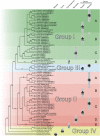

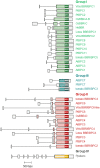




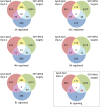


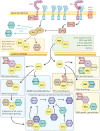
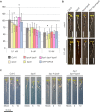
Similar articles
-
The Arabidopsis GAGA-Binding Factor BASIC PENTACYSTEINE6 Recruits the POLYCOMB-REPRESSIVE COMPLEX1 Component LIKE HETEROCHROMATIN PROTEIN1 to GAGA DNA Motifs.Plant Physiol. 2015 Jul;168(3):1013-24. doi: 10.1104/pp.15.00409. Epub 2015 May 29. Plant Physiol. 2015. PMID: 26025051 Free PMC article.
-
Plant BBR/BPC transcription factors: unlocking multilayered regulation in development, stress and immunity.Planta. 2023 Jun 27;258(2):31. doi: 10.1007/s00425-023-04188-y. Planta. 2023. PMID: 37368167 Review.
-
Family Members Additively Repress the Ectopic Expression of BASIC PENTACYSTEINE3 to Prevent Disorders in Arabidopsis Circadian Vegetative Development.Front Plant Sci. 2022 May 26;13:919946. doi: 10.3389/fpls.2022.919946. eCollection 2022. Front Plant Sci. 2022. PMID: 35693178 Free PMC article.
-
Genome-Wide Identification and Characterization of Basic Pentacysteine Transcription Factors in Brassica napus.Plants (Basel). 2025 Apr 6;14(7):1136. doi: 10.3390/plants14071136. Plants (Basel). 2025. PMID: 40219204 Free PMC article.
-
Evolution goes GAGA: GAGA binding proteins across kingdoms.Biochim Biophys Acta. 2012 Aug;1819(8):863-8. doi: 10.1016/j.bbagrm.2012.02.022. Epub 2012 Mar 8. Biochim Biophys Acta. 2012. PMID: 22425673 Review.
Cited by
-
Integrating QTL mapping and transcriptomics to decipher the genetic architecture of sterol metabolism in Brassica napus L.Hortic Res. 2024 Jul 24;11(9):uhae196. doi: 10.1093/hr/uhae196. eCollection 2024 Sep. Hortic Res. 2024. PMID: 39257541 Free PMC article.
-
Deep learning the cis-regulatory code for gene expression in selected model plants.Nat Commun. 2024 Apr 25;15(1):3488. doi: 10.1038/s41467-024-47744-0. Nat Commun. 2024. PMID: 38664394 Free PMC article.
-
Genome-Wide Identification of BPC Gene Family in Ten Cotton Species and Function Analysis of GhBPC4 Involved in Cold Stress Response.Int J Mol Sci. 2025 Aug 18;26(16):7978. doi: 10.3390/ijms26167978. Int J Mol Sci. 2025. PMID: 40869299 Free PMC article.
-
Genome-wide chromatin accessibility analysis unveils open chromatin convergent evolution during polyploidization in cotton.Proc Natl Acad Sci U S A. 2022 Nov;119(44):e2209743119. doi: 10.1073/pnas.2209743119. Epub 2022 Oct 24. Proc Natl Acad Sci U S A. 2022. PMID: 36279429 Free PMC article.
-
Association Mapping of Amylose Content in Maize RIL Population Using SSR and SNP Markers.Plants (Basel). 2023 Jan 4;12(2):239. doi: 10.3390/plants12020239. Plants (Basel). 2023. PMID: 36678952 Free PMC article.
References
-
- Berendzen K. W., Stuber K., Harter K., Wanke D. (2006). Cis-motifs upstream of the transcription and translation initiation sites are effectively revealed by their positional disequilibrium in eukaryote genomes using frequency distribution curves. BMC Bioinformatics 7:522. 10.1186/1471-2105-7-522 - DOI - PMC - PubMed
LinkOut - more resources
Full Text Sources

